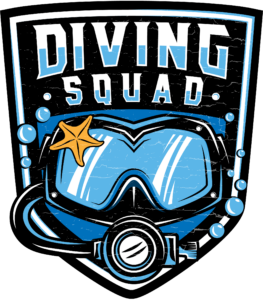10 Best Dive Computers of 2024
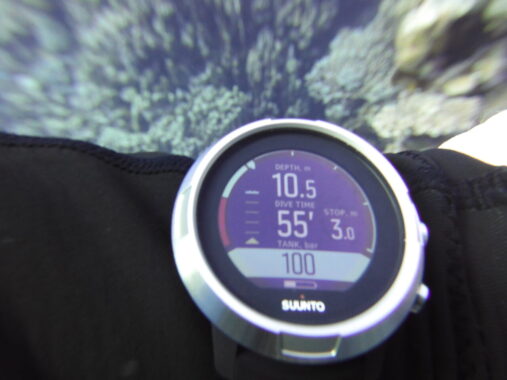
When it comes to choosing the best dive computer for you, there’s a whole bunch of stuff to consider.
Maybe you’re a complete newbie diver; in which case, you may opt to buy a beginner dive computer that provides only the most essential dive-profile data.
Or perhaps you’re a more experienced diver looking to upgrade to a sleeker model of dive computer with special features.
As the price bar slides up, dive computers get increasingly slick with full-colour displays and special features such as air integration (remaining air time), compasses and fitness apps.
We’ve reviewed the best dive computers of 2024 with stat breakdowns, pros, cons and more.
Dive down to the QUICK ANSWER for a brief synopsis of each one or descend deeper for our Detailed Reviews.
My favourite dive computer is the Suunto D5. It is stylish, has a beautiful colour-coded HD display and tons of cool extra features like air integration and a digital compass.
How did we create these reviews you ask? By being colossal scuba nerds! We’ve created first-hand reviews of our own dive computers; whilst also interviewing other divers about theirs.
We tested and rated these dive computers according to their features, user-interface, aesthetic design and value for money. Each one has been assigned a title that describes it best.
We played around with each dive computer on a variety of dives and often had several different people try it before combining their feedback into an all-encompassing review.
Whose we? These reviews were created by myself, other members of the Diving Squad and yet other divers I’ve met throughout my many scuba-adventures – Alex.
Alex

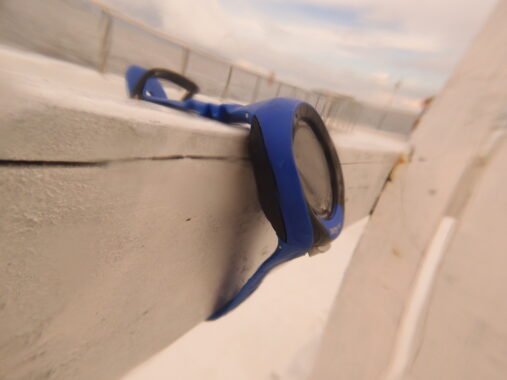
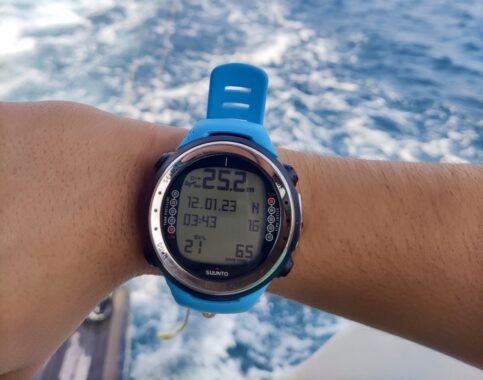
Alex
QUICK ANSWER:
1) Best Dive Computer Overall: Suunto D5
Full Colour LED Display
Air Integration & Compass
Watch-Sized
2) Best Luxury Dive Computer: Garmin Descent MK2i
SmartWatch Functions
Full Colour LED Display
Air Integration & Compass
Watch-Sized
3) Cheapest Dive Computer: Cressi Leonardo
Dot-Matrix Display
1 Button Interface
Chunky Sized
4) Best Dive Computer for Beginners: Suunto Zoop Novo
Dot-Matrix Display
4 Button Interface
Chunky Sized
5) Newest Release: Apple Watch Ultra
Smart Watch
Dive Computer Functions
Only Operates to 131ft / 40m
6) Cheapest Watch-Sized Dive Computer: Suunto D4i Novo
Dot Matrix Display
Air Integration
4 Buttons
7) Cheapest Dive Computer with HD Screen: Deepblu Cosmiq+
LCD Display (high contrast screen)
Rechargeable
2 Buttons
8) Best Tec Diving Computer: Shearwater Teric
Dedicated Tec Mode
LED High Contrast Display
Watch Sized
9) Best for Underwater Photographers: Shearwater Nerd 2
Positioned over mask
Full Colour LED Display
Air Integration & Compass
10) Best Console Dive Computer: Oceanic Pro Plus X
Console Dive Computer
High Contrast LED Display
Air Integration included
3D Compass
REVIEWS: Best Dive Computers of 2024
- TOP PICK: Suunto D5
- Best Luxury Dive Computer: Garmin Descent MK2i
- Cheapest Dive Computer: Cressi Leonardo
- Best Dive Computer for Beginners: Suunto Zoop Novo
- Newest Release: Apple Watch Ultra
- Cheapest Watch-Sized Dive Computer: Suunto D4i
- Cheapest HD Screen Dive Computer: Deepblu Cosmiq+
- Best Tec Diving Computer: Shearwater Teric
- Best for Underwater Photographers: Shearwater Nerd 2
- Best Console Dive Computer: Oceanic Pro Plus X
1) TOP PICK: Suunto D5

- Price:> $$
- Full Colour LED Display
- Air Integration
- Digital Compass
- Air, Nitrox, Free Dive & Off Modes
- Rechargeable Battery (7 Hours)
- 200 Hour Logbook
“Stylish, durable and easy to use; the Suunto D5 is my favourite dive computer of all time – it’s so cool looking and the full-colour screen is awesome”! Alex: Grand Admiral of the Diving Squad
The D5 is an extremely sleek-looking, watch-sized dive computer with a stylish, semi-nautical looking metallic bezel…it’s also the cheapest dive computer to feature a beautiful full-colour LED screen with high-contrast!
You can even adjust the brightness of the backlight to make it bright enough to see on a night-dive without shining a torch on it!
It operates in air, nitrox, freedive and gauge mode and uses Suuntos fused RGBM2 algorithm; with 5 levels of adjustment to make it more – or less conservative than the standard setting.
The 3 button user-interface is extremely intuitive and easy to navigate; despite the variety of settings and data layouts you can choose from.
We love the compass although you do have to recalibrate it after recharging the Suunto D5, which has a (shortish) battery life of 7 – 12 hours in dive mode before needing to be recharged with the included USB cable.
This is an air integrated dive computer – you can buy a Suunto air integration pod for a few hundred bucks extra and pair it up with the D5 to get tank pressure / remaining air readings.
There’s just so many awesome things about the Suunto D5 – it’s a hugely popular dive computer within the recreational scuba diving community and offers fantastic value for money.
PROS:
- Easy to Read Display
- Durable
- Simple User-Interface
- Inbuilt Compass
- Air Integration
- Adjustable RGBM algorithm
CONS:
- No smartwatch functions
- No tec mode
- Fairly short battery life (7 hours)
2) Best Luxury Dive Computer: Garmin Descent MK2i
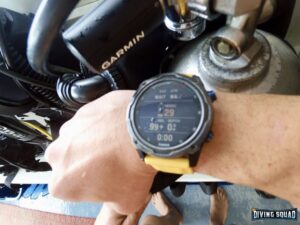
- Price: > $$
- SmartWatch Functions
- Air, Nitrox, Gauge, Freedive, Spearfish, Open-Circuit & Mixed Gas Modes
- Full-colour LED Display
- Digital Compass
- Air Integration
- Recharging dock – 80 hours in dive mode
- 200 hour dive log
A marked step-up from it’s predecessor: the MK1 – both in price and quality, the Garmin Descent MK2i is a watch-sized dive computer with smartwatch functionalities and tons of great features for divers.
It features a truly beautiful, full-colour display; which at 1.6 inches in diameter is 36% bigger than that of the MK1.
The MK2i also has the longest rechargeable battery life of any dive computer on our list – at a mammoth 80 hours in dive mode!
Its absolutely crammed with smartwatch functions: wrist-based heart monitoring, pulse ox, training features like animated workouts and sports apps, smartphone syncing, Garmin Pay, music storage and more!
There’s so many settings and features that we’re glad the MK2i has 5 buttons which makes it super quick to navigate through the user-interface – which is actually pretty intuitive once you get used to it.
Operating in single or multi-gas modes as well as in freedive, spearfish and gauge; it’s suitable for recreational and tech scuba divers on air, nitrox or mixed gas / with rebreathers – as well as for spearfishing and freediving!
We’re also huge fans of the internal compass which uses GPS syncing to mark your dive entry and exit marking points.
Also, Garmin have finally included air integration tech in the MK2i (none of the cheaper Garmin dive computers have this option).
What’s more, using wireless transmitters you can pair the Garmin Descent MK2i with up to 5 other tanks with data on remaining air time, air consumption rate and more.
The dive log has a good amount of space, being able to store up to 200 dives and you can easily view and save this dive profile data by syncing the Descent MK2i up with your smartphone.
If you can afford it, the Garmin Descent MK2i is, in our humble opinions, the absolute best dive computer with smartwatch functions currently on the market!
PROS:
- Works as SmartWatch with Fitness Apps
- Huge Battery Life (80 hours)
- HD LED Display
- Air Integration
- Highly Customisable
- Inbuilt Compass
- Suitable for recreational tec and freediving
CONS:
- Expensive
- 328 feet maximum depth means it won’t be suitable for more advanced tec divers
3) Cheapest Dive Computer: Cressi Leonardo
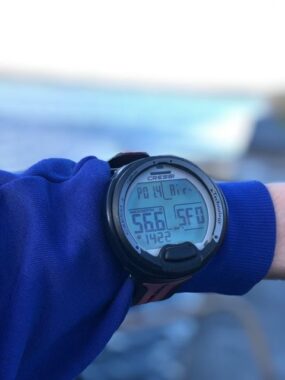
- Price: > $
- Air, Nitrox & Gauge Modes
- Dot-Matrix Display
- Chunky Size
- Lithium Battery: 150 Dives
- 70 Hour Logbook
- 132 feet Max Depth
By far the cheapest dive computer on our list is the Cressi Leonardo which provides all the essential dive computer functions a recreational scuba diver needs including air, nitrox and gauge modes.
Following a chunky, old school dive computer design, is is also the biggest dive computer model with a bezel diameter of 2.6 inches / 66mm.
Its chunkiness makes the Cressi Leonardo tough and durable – it also means its dot-matrix display is extra large and easy to read.
You operate it with just one button which makes the user interface extremely simple to use – albeit not quite as fast as dive computers with more buttons!
The lithium battery lasts for 150 dives before it has to be changed (which can easily be done by sending it to a Cressi service centre!). Also, the logbook which records dive profile data has a pretty decent capacity of 70 hours!
It’s maximum depth is 132 feet – recreational diving limits are 130 feet and in truth are usually shallower – so the Cressi Leonardo will have recreational divers covered!
This is a great first time dive computer for beginners – its super affordable, easy to use and reliable.
For overall value for money and quality we give it a solid 4 / 5.
PROS:
- Super cheap!
- Easy to use.
- Durable.
- Has all the major functions for a recreational diver needs.
- Range of colours.
- Great value for money.
CONS:
- Does not have features of more advanced dive computers:
- No compass, no air integration, no smartwatch, cannot make decompression algorithm less conservative.
- Dot-matrix display = no colour on the screen.
- User-interface a little slow to navigate due to only 1 button.
4) Best Dive Computer for Beginners:
Suunto Zoop Novo
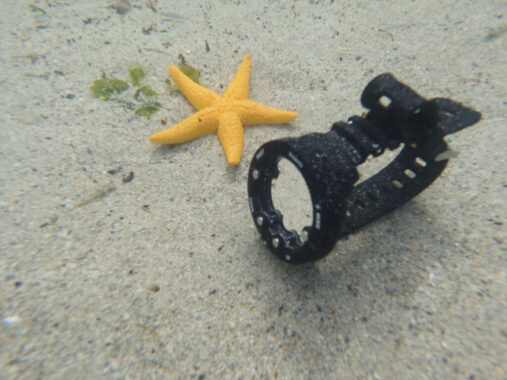
- Price: > $
- Air, Nitrox, Gauge & Free Dive Modes
- Large Dot-Matrix Display
- Chunky Sized Dive Computer
- Lithium battery: 150 Dives
- 140 Hour Logbook
- 262 Feet Maximum Depth
- 4 Buttons
“Ahhh the Suunto Zoop Novo – I remember it well! This guy was my first ever dive computer and served me most awesomely”! – Alex Grand Admiral of the Diving Squad.
The Suunto Zoop Novo is another chunky dive computer that follows an old-school design.
Rugged and durable, it’s not quite as cheap as the Cressi Leonardo but features a logbook that’s twice as long with a capacity of 140 dives!
You can take it twice as deep as the Leonardo – all the way to 262 feet which is also twice the limit for recreational scuba diving!
It’s a smidge smaller with a bezel diameter of 2.4 inches meaning it’s dot-matrix display is still larger than that of most pricier, watch-sized dive computers and thus super easy to read.
You can quickly navigate through the simple user interface via the four buttons – admittedly these buttons are a little stiffer compared to those of some other dive computers… but don’t worry – you’ll still be able to make them work: we believe in you!
The Suunto Zoop Novo operates in air, nitrox, gauge – and also free dive mode which is a handy bonus if as well as scuba diving you want to try free diving.
Running on the Suunto RGBM algorithm, it allows you to adjust the safe diving limits that it provides to be more conservative – in case you have pre-existing medical conditions. You still can’t make it less conservative though as you can with some pricier dive computers.
It runs on a lithium battery that has to be changed after 150 dives which you can do yourself if you’ve got some knowhow or get someone else to by simply sending it off to your nearest Suunto service centre.
We’re big fans of the Suunto Zoop Novo – it’s only a shame that online stocks for them are relatively limited these days! However, there’s still a few out there.
PROS:
- Cheap!
- Easy to use.
- Durable.
- Has all the major functions for a recreational diver needs. Plus freediving.
- Range of colours.
- Awesome value for money.
- You can adjust the algorithm to make it more conservative.
CONS:
- Does not have features of more advanced dive computers:
- No compass, no air integration, no smartwatch, cannot make decompression algorithm less conservative.
- Dot-matrix display = no colour on screen.
- Buttons a little stiff.
5) Newest Release: Apple Watch Ultra
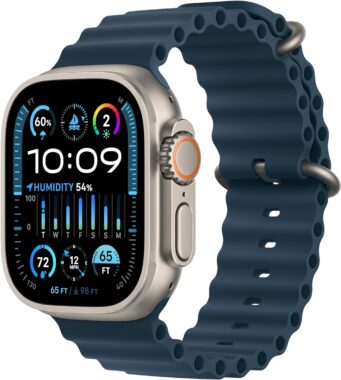
- Price: > $$
- SmartWatch Functions
- High Contrast LED Display
- Works in tandem with Oceanic+ App
- Functions to 131ft / 40m
Apple have made a huge splash with their newest release: the Apple Watch Ultra which not only retains the smart-health watch functionalities of previous apple smart watches, but now also serves as a dive computer.
Working in tandem with the Oceanic+ App, it provides all the data required of a dive computer: no deco time, depth, dive time, temperature and so forth with air and nitrox modes.
However, it’s worth noting that you do need a subscription to the Oceanic+ App to access the dive computer feature of the Apple Watch Ultra, which costs a little extra!
Data is displayed on the full-colour, high definition display which features a sapphire front to prevent scratching.
The touchscreen locks underwater so on dives you’ll operate the apple watch ultra via the wheel and single button.
One disadvantage of the Apple Watch Ultra is that whilst its waterproof to 328 feet / 100 meters, the onboard sensors only have gauges that measure depths to a maximum of 131 ft / 40 m.
Now recreational scuba diving limits are actually 98 – 131ft (30 – 40m) so most divers will be fine with these limits; however some…ahem…misbehaving (!) divers (such as myself – huhuhu!) do occasionally exceed these limits.
However, if you’re sensible and adhere to the guidelines and protocol of recreational diving, the Apple Watch Ultra will have you covered.
This piece of kit is a durable, reliable and nice looking piece; with all the fantastic features that we already know and love of apple smart watches and now with the added benefit of serving as a dive computer.
PROS:
- Awesome smart watch functionality
- High definition, incredibly bright screen
- Easy to use
- Durable and reliable
CONS:
- Have to subscribe to oceanic app
- Sensor gauges only works to 131ft / 40m (recreational diving limits).
- No air integration tech
6) Cheapest Watch Sized Dive Computer: Suunto D4i Novo

- Price: > $$
- Air, Nitrox, Gauge & Freedive Modes
- Watch-Sized
- Air Integration
- Dot-Matrix Display
- Lithium Battery: 150 Dives
- 140 Hour Dive Log
The Suunto D4i / Novo is the cheapest watch-sized dive computer out there!
In fact; with a diameter of 1.91 inches / 48.6 mm, it’s a little smaller than some watches even are. This definitely gives it a sleek, minimalist appearance.
It’s also the cheapest dive computer on our list to feature air integration tech. When paired with a wireless Suunto Tank Pod, the D4i Novo provides tank pressure readings – aka how much air you’ve got left.
Just bear in mind that you do have to buy the Tank Pod separately and it costs a few hundred bucks.
The Suunto D4i Novo is available in several colours and has a lithium battery that lasts for 150 dives and a 140 hour dive log.
It would be great if you could bluetooth pair it to a smartphone or computer to download these dives super easily rather than having to use the USB cable to do so – but thats no big deal!
The Suunto D4I NOVO can go to 328 feet deep and is operated via four buttons which makes it incredibly quick to switch through the settings – once you know you’re way around the layout.
The display is a dot-matrix one with an adjustable backlight; it would be nice to see a LCD or LED colour screen for some colour instead of pixels considering we’re now in lower mid-priced dive computer territory.
By the way, the Suunto D4i Novo is a mild update of its predecessor – the Suunto D4i. Literally the only difference between these 2 dive computers is that the D4i has plastic buttons whereas the D4i Novo has metal ones!
PROS:
- Watch-sized
- Optional air integration
- Air, Nitrox, Gauge AND Freedive Modes
- Silicone strap for extra comfort
- Durable
- Good value for money
CONS:
- Dot-matrix (colourless) display despite being low mid-priced.
- Does not have features of more advanced dive computers:
- No compass and no smartwatch functions.
7) Cheapest Dive Computer with HD Screen: Deepblu Cosmiq+
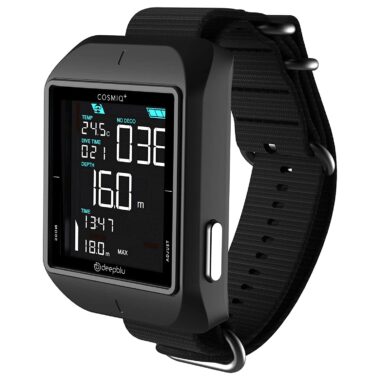
- Price: > $
- Air, Nitrox, Gauge & Freedive Modes
- LCD Display (high contrast!)
- USB Rechargeable – 12 hours
- 160 Hour Dive Log
- 328 feet Max Depth
- 2 Button
The Deepblu Cosmiq+ is the cheapest dive computer on our list to feature a HD (high definition) screen i.e. an LCD display!
This is a marked step-up from a pixelated dot-matrix display (as so far seen in dive computers #1, #2 and #3) as an LCD display offers higher contrast making it extra easy to read in any light!
At 2.2 inches across, the display is just so effortless to read – even on a night dive you can clearly see it without having to shine your torch on it!
It’s fairly intuitive user-interface is operated via 2 buttons and the maximum depth rating is 328 feet – same as max recreational scuba diving limits.
We like that the information is colour coded in blue and white – as well as making it a few nanoseconds quicker to mentally process, it makes the whole thing look pretty futuristic and swish.
Whereas most cheap dive computers alarms are audible, in the case of the Deepblu Cosmiq: in addition to an audible alarm it also flashes and vibrates when issuing warnings (e.g. rapid ascent).
It charges via a USB magnetic charging device and lasts for 12 hours in dive mode.
At 160 hours long, its logbook has a pretty decent capacity and it’s an absolute breeze adding details to or saving data from it using the Deepblu App.
PROS:
- LCD Screen = Extra Easy to Read
- Operates in the major modes: Air, Nitrox, Gauge + Free Dive
- Rechargeable – USB cable.
- Huge Dive Log
CONS:
- Not as durable as some other dive computers.
- Does not have features of more advanced dive computers:
- No compass, no air integration, no smartwatch…
8) Best Tec Diving Computer: Shearwater Teric

- Price: > $$$
- Dedicated Tec Dive Mode
- Air, Nitrox, Gauge, Trimix, Mixed Gas, Tec, Freedive & Open Circuit Modes
- LED HD Display
- Inbuilt Compass
- Rechargeable battery (30 hours)
- 500 Hour Dive Log
- 660 ft Max Depth
Tec diving involves going much deeper than recreational diving limits allow, using multiple tanks and gas blends. It’s a truly hardcore sport and one that requires great skill and training.
If you are a tec diver, you’ll know that you need a dive computer that can operate in TEC mode – this is a pretty specialised function that only dive computers designed for tec diving tend to have.
In the case of the Shearwater Teric – it was very much designed for tec diving but is also great for recreational diving; it can go to 660 feet / 201 meters deep and operates in Air, Nitrox, Mixed Gas, Trimix, Gauge, Freedive, Tec and Open-Circuit modes!
We really love the fact that it won’t lockout after a missed stop or ascent rate violation (whereas the vast majority of other dive computers do rendering them useless for 24 hours!).
It follows an old-school wristwatch design and looks rugged yet sophisticated with black, silver and blue bezel colour options.
Users will quickly realise that so many settings and custom configuration do mean the Shearwater Teric takes a little getting used to. However once you know your way around it, there’s so much you can do.
For example, you can set a button to give you single press access to its many tools – which include a 3-axis inbuilt compass, stopwatch and countdown timer.
There is also the option for air integration tech – with separately purchased transmitters you can pair it with up to two tanks to the Teric dive computer!
It may be expensive, but the Shearwater Teric is a seriously capable dive computer with a beautiful design and all the capabilities and modes required for intermediate-level tec diving.
PROS:
- Operates in Tec, Trimix, Mixed Gas and Open Circuit Modes
- Huge Dive Log (500 hours)
- High Definition LED display
- Highly Customisable
- Inbuilt Compass
- Long Rechargeable Battery Life (30 hours)
CONS:
- Expensive
- No smartwatch functions
- Custom setup takes a little getting used to
9) Best Dive Computer for UW Photographers: Shearwater Nerd 2
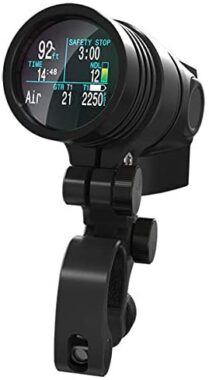
- Price: > $$$
- Near-Eye Position
- Air, Nitrox Mixed Gas and Tec Modes
- Full-Colour LED Display
- Inbuilt Compass
- Air Integration
- Lithium battery – 500 Dives
- 1000 hour dive log
The Shearwater Nerd 2 is unique for being the only dive computer with a design thats neither wristwatch nor console: instead is is the only near-eye remote dive computer!
You secure the Nerd 2 onto your primary first stage regulator (the first bit of the regulator hose coming away from the reg in your mouth!) so that the display is just a few inches away from your eye.
The result is that the micro-LED display, with it’s magnifying lens; makes data appear as if you’re looking at it from a 25 inch TV thats directly in front of you four meters away – awesome!
Such a setup is extra handy for underwater photographers because it means being able to see dive data without moving your body – as you would when glancing down at a dive computer on your wrist or console.
This is super handy when using an underwater camera, because it means you wont loose your subject from the frame.
Operating in air, closed-circuit, gauge and tech mode and with an insane depth rating of 985ft the Shearwater Nerd 2 is suitable for both recreational and tec scuba divers.
The 2 buttons on either side of it are easy to locate and operate even with thick dive gloves and the user interface is both intuitive and well laid out.
It has a colossal 1000 hour dive log – the biggest of any dive computer on our list as well as air integration tech and an inbuilt compass.
The Nerd 2 is an awesome and unique concept for a dive computer; with special advantages for underwater photographers and great all-round functionality for scuba divers.
PROS:
- Unique Design for Photographers
- View data without moving
- High Definition LED display (extra large)
- Inbuilt Compass
- Air Integration Tec
- Durable
CONS:
- Expensive
- No freedive mode
- No smartwatch functions
10) Best Console Dive Computer: Oceanic Pro Plus X
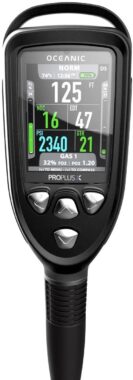
- Price:> $$$
- Console Dive Computer
- Air Integration included
- Air, Nitrox & Gauge Modes
- Huge full-colour LED display
- Adjustable Brightness
- 3-D Compass
- Rechargeable lithium battery: 35 – 40 hours at 100% brightness
- 65 hour dive log (approx)
Whereas a normal / wrist dive computer is worn like a watch, a console dive computer is attached directly to your tank via a regulator hose in place of (or combined with) the pressure gauge.
That’s exactly what the Oceanic Pro Plus X does – and its the absolute best console dive computer for recreational scuba diving out there!
The display is a (huge) low energy consumption thin-film LED transmitter.
Data is displayed via an intuitive colour-coded system in huge, high-definition figures. You can adjust the brightness to sunlight or night dive conditions.
The display specially shines through when you use the 3D compass, which is massive and looks truly superb.
The Oceanic Pro Plus X operates in air, nitrox and gauge modes and can be taken to a maximum depth of 330 feet; nearly three times the limit for recreational scuba diving.
Because it attaches to your tank, air integration readings i.e. tank pressure / remaining air are automatically provided – no need to pay extra for a transmitter!
The dive log which has a capacity of 99 dives which is about 65 hours.
This is actually not much space for a logbook – but at least it’s a breeze to save data from the dive log as you can effortlessly connect the Oceanic Pro Plus X to a computer or tablet using bluetooth.
PROS:
- Huge full-colour LED display
- Air integration included
- 3-D compass
- Air, Nitrox & Gauge modes
- Long-lasting (rechargeable) lithium battery
- Console dive computer – will appeal to some
- Easily connects to devices via bluetooth
CONS:
- Logbook is fairly short (65 hours)
- No tec mode
11) Cheap Dive Computer with Huge Battery: Mares Puck Pro

- Price: > $
- Air, Nitrox & Gauge Modes
- Dot-matrix display (medium-sized)
- Cr 2450 battery: lasts 400 dives
- 36 hour Dive Log
- 492 feet Max Depth
- 1 Button
The Mares Puck Pro is a super affordable and easy to use dive computer.
It’s similar to but a little smaller than the Zoop Novo and Cressi Leonardo – however with a bezel diameter of 2.2 inches, it is still bigger than a smartwatch-sized dive computer.
Now, there’s some parts of the Mares Puck Pro we’re huge fans of – and others not so much!
For starters, we like that it has a massive battery life of 400 hours which is way bigger than that of other cheap dive computers.
It’s also pretty neat that it has a freshwater calibration as well as a residual nitrogen memory reset and multi-gas capacity. And that comes comes in a huge range of colours!
What we don’t like about the Puck Pro is the feeble logbook capacity of just 36 hours – which is much smaller than that of almost all other dive computers.
We also have mixed feelings on the single button which makes it simple to navigate through the user interface but take a little longer to apply those special features like the freshwater setting.
All things considered, there are some nice stand out points for the Mares Puck Pro but a couple of areas that that it falls short.
Ultimately, it is still a nice and affordable dive computer that will make a good first time purchase for a beginner or early-intermediate scuba diver.
PROS:
- Has all the major functions for a recreational diver needs.
- Special settings: freshwater, salinity, multi-gas, residual nitrogen memory reset.
- Huge battery life for cheap dive computer (400 dives).
- High depth-rating (492 feet).
CONS:
- Tiny dive log! (36 hours).
- Does not have features of more advanced dive computers:
- No compass, no air integration, no smartwatch, cannot make decompression algorithm less conservative.
- Dot-matrix display = no colour on screen.
- 1 button interface means it is not the fastest when applying the special settings.
12) Huge Battery Life: Oceanic Geo 4.0
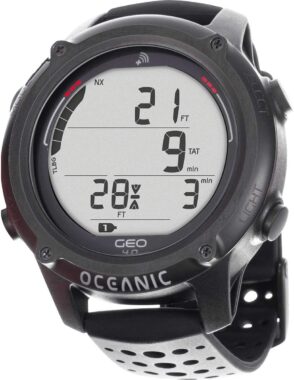
- Price: > $
- 300 Hour Lithium Battery
- 24 Hour Dive Log
- Dot Matrix Display
- Max Depth Rating: 330ft
The Oceanic Geo 4.0 is an affordable, no-frills attached dive computer that has the added bonus an extra long battery life of up to 300 hours – which is bigger than that of most other dive computers.
What’s strange then, is that its dive log capacity is smaller than of any other dive computer – with a truly feeble capacity of just 24 dives!
At least the Oceanic Geo 4.0 features bluetooth connectivity allowing you to quickly and easily save older dives via the Oceanic+ App before they get overwritten.
It operates in air, nitrox, gauge and free dive modes and with an impressive maximum depth rating of 330 feet, is more than suitable for all forms of recreational diving.
Because theres no unnecessary features, the Geo 4.0 is an exceptionally straightforward to use dive computer with a simple user-interface thats operated via 4 buttons – which are easy to press even with thick gloves.
In our opinion, this is a nice and simple dive computer; durable, simple to use and providing everything a recreational diver needs at a reasonable price with no extra fluff.
PROS:
- Straight-forward
- Minimalist design and features
- Durable
- Long battery life
- Decent depth rating
CONS:
- Tiny dive log (24 dives).
- Dot-matrix (colourless) display.
- Does not have features of more advanced dive computers:
- No compass, no air integration and no smartwatch functions.
13) Affordable Shearwater for Recreational Diving: Shearwater Peregrine
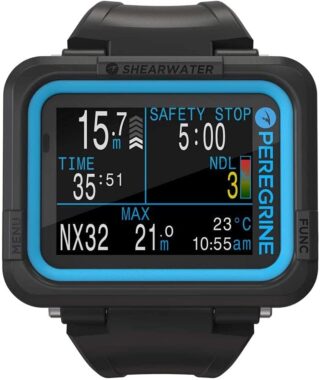
- Price: > $$
- Air, Nitrox, Mix-Gas & Gauge Modes
- Huge LED display (ultra-high contrast)
- USB rechargeable – 30 hours
- 200 hour dive log
- 390 feet max depth
- 2 buttons
Shearwater are a legendary name; renowned for making extremely durable and high performing dive computers that are crammed with features. The downside is that they’re often quite expensive.
But in the case of the Shearwater Peregrine: it’s actually the cheapest dive computer of the Shearwater range and is very reasonably priced indeed, sitting at the lower end of the mid-price spectrum.
Its most visually defining feature is the huge, full colour 5.59 inch LED screen which has a vivid colour range and saturation display. It’s incredibly easy to see, in literally any light (even at night, with no torch!).
Having such a big screen means the Peregrine has space for both more and larger readings, making it super easy to read the dive info; you also have the option to customise which dive data is displayed!
Despite how customisable this dive computer is, it’s actually very easy to use: you navigate through the setup via the simple 2-button user-interface.
Operating in air, nitrox, mix-gas and gauge modes, the Shearwater Peregrine is battery rechargeable and has a huge charge of 30 hours in dive mode and a very impressive dive log capacity of 200 hours.
This is a seriously nice and cool looking dive computer; one that’s dedicated entirely for the function of scuba diving, which it exceeds at. It’s super affordable and offers awesome value for money.
One thing we will say however, is that the Peregrine doesn’t have an air integration option – nor does it feature an inbuilt custom – it would be so much more epic if it did have these two things!
However, Shearwater have addressed this; their next dive computer up: the similar looking but higher-quality Shearwater Perdix has both air integration and an inbuilt compass (as well as a bigger dive log!).
PROS:
- Huge, high-contrast LED display
- Customize which dive data you see
- Ultra durable
- Air, Nitrox and Gauge Modes PLUS Mix-Gas
- Huge dive log (200 hours)
- Massive rechargeable battery life (30 hours
- Affordable
- Great value for money!
CONS:
- Does not have features of more advanced dive computers: No compass, no air integration, no smartwatch functions.
- Too big to serve as every-day watch.
14) Cheapest Dive Computer with SmartWatch Functions: Garmin Descent G1
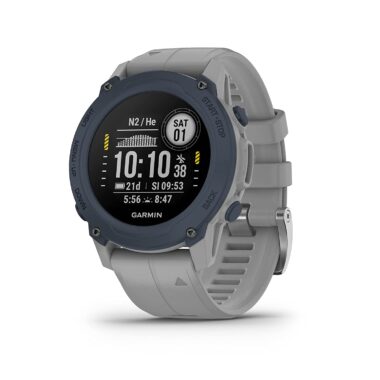
- Price: > $$
- Air, Nitrox, Freedive, Gauge, Tech, Spearfishing
- Smartwatch Functions
- High Definition LED display
- Compass + GPS
- USB Rechargeable – 25 hours
- 200 hour dive log
The Garmin Descent G1 is the cheapest dive computer with smartwatch functionalities!
By monitoring the wearers heart-rate, body energy and sleep patterns, it provides health and fitness insights and lets you know when to slow down!
You can track your activities with 30 + built-in sports apps that use advanced training features and let you know how your body is adapting.
There’s also the option to pair the G1 with your smartphone via the Garmin connect app to send text and call notifications as well as make contactless payments with Garmin Pay.
This is a beautiful looking watch-sized dive computer with a high-contrast LCD display behind a scratch-resistant sapphire lens and worn with a comfortable silicone strap.
It operates in Air, Nitrox, Freedive, Tech, Spearfishing and Closed-Circuit Rebreather modes – awesome!
Its maximum depth rating is 328 ft / 100m – which will suit most tech divers – although hard core techies will probably want something that goes deeper.
There’s an inbuilt compass which nicely syncs up with the GPS support feature, allowing you to mark your surface entry and exit points at the start and end of each dive.
With a rechargeable battery that lasts for 25 hours in dive mode and a whopping 200 hour dive log, the Descent G1 has some formidable stats.
It would be nice if it also featured air integration tech – but that’s a small(ish) price to pay for a dive computer with smartwatch capabilities being so affordable.
If you do want something like that but also with air integration (and able to go deeper), you’ll have to splash out a little more.
PROS:
- Smartwatch functions
- Great value for money
- Inbuilt compass + GPS
- High definition LED display
- Air, Nitrox and Gauge Modes PLUS FREEDIVE, TECH & OPEN-CIRCUIT REBREATHER
- Huge dive log (200 hours)
- Long battery life (25 hours)
CONS:
- No optional air integration.
- Would be nice if it could go deeper for hardcore tech divers.
15) Mid-Priced Dive Computer with Smart Watch Functions: Garmin Descent MK1
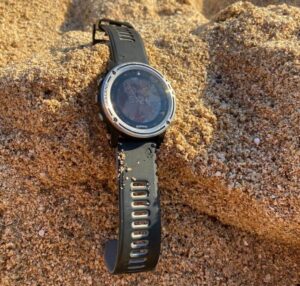
- Price: > $$
- Air, Nitrox, Spearfishing, Freedive, Gauge & Trimix Modes
- Full Colour LED display
- Smartwatch Functions
- Compass + GPS
- USB rechargeable – 40 hours
- 200 hour dive log
- 328 feet max depth
The Garmin Descent MK1 is a step-up from the Descent G1 (#8). It’s a little pricier; but features a full-colour LED screen with super high contrast!
Its incredibly smart; a little more streamlined and easily doubling up as the sort of subtly flashy watch you could wear to a formal event like a business meeting.
In terms of functionality and performance the Garmin Descent MK1 is fairly similar to the G1.
It features smartwatch functionality with heart rate, energy and sleep monitoring tech, smartphone sync compatibility and multiple sports-training apps, stats and smart notifications.
Modes of operation include Air, Nitrox, Freedive, Spearfishing, Gauge diving but in the place of a Tec Mode theres a a Trimix mode.
The rechargeable battery life lasts up to a whopping 40 hours in dive mode: although at 200 hours long, the dive log capacity is the same – as is max-depth at 328 feet.
We love the 3-axis compass which syncs up flawlessly with the GPS feature and automatically marks your entry and exit points on dives with onscreen mapping and location reference.
There’s no air integration tech; Garmin finally address this in their next dive computer up, the more expensive Garmin Descent MK2.
Still, the Descent MK1 is a dive computer that offers awesome value for money with its beautiful LCD colour display, smartwatch functions, compass, GPS and multiple modes.
PROS:
- Full-colour LCD display
- Awesome value for money
- Smartwatch functions
- Inbuilt compass + GPS
- High definition LED display
- Air, Nitrox and Gauge Modes PLUS FREEDIVE, SPEARFISH & TRIMIX
- Long dive log (200 hours)
- Huge rechargeable battery life (40 hours)
CONS:
- No air integration.
- No tech mode
16) Rectangular Tec Dive Computer: Shearwater Perdix
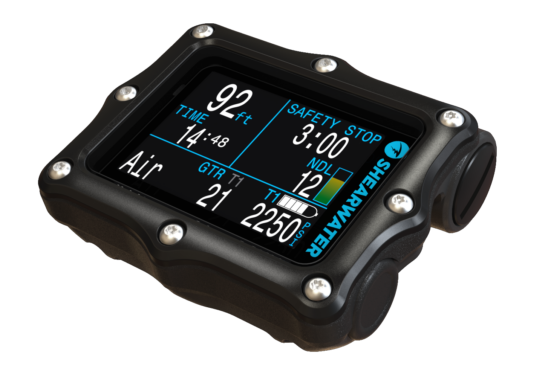
- Price: > $$$
- Tec Diving Mode
- Air, Nitrox, Gauge, Trimix, Mixed Gas, Tec & Open Circuit Modes
- Huge rectangular LED display
- Toughened Aluminosilicate Glass
- Compass
- Charged by AA batteries – lasts 40 – 60 hours depending on battery type (lithium is best)
- 1000 hour dive log (approx)
- 853 feet max depth
The Shearwater Perdix lets you get even more hardcore with your tec diving – it can go to an insane 853 feet / 260 meters and also operates in Air, Nitrox, Mixed Gas, Trimix, Gauge, Tec and Open-Circuit modes!
It is insanely rugged; sporting a titanium bezel and a toughened aluminosilicate glass screen for next level durability.
The huge rectangular display measures 5.1 x 4.1 inches on a backlit screen with adjustable brightness and high-definition colour.
Having such a huge screen makes dive data extra easy to read and mentally process – it does mean that the Perdix is too massive and chunky to double up as an everyday wristwatch though!
Users can choose which data they see and the order in which it is displayed. However, despite how many settings and options there are, the 2 button user-interface is really easy and straightforward to get used to.
Theres also an inbuilt compass, optional air integration and a truly colossal logbook with a 1000 hour capacity – the longest of any dive computer on our list!
The fact that its pretty damn expensive, means buyers may be wise to only get the Shearwater Perdix if they plan on using it for its primary function: tec diving.
But there’s no denying that it one highly sophisticated and insanely durable piece of kit that does its job very well.
PROS:
- Insanely durable
- Operates in Tec, Trimix, Mixed Gas and Open Circuit Modes (as well as normal: air, nitrox and gauge).
- Can take to 853 deep!
- Colossal dive log (1000 hours)
- High definition LED display
- Easy to use
- High level of customisation
- Inbuilt compass
- Optional air integration
CONS:
- Expensive
- No smartwatch functions
- Recreational divers may find it has too many settings and modes making it over-complicated
- No freediving mode.
SPECS Comparison: 16 Best Diving Computers
We’ve painstakingly compiled all the most vital specs and stats to consider when buying a dive computer, into one handy table! As with the reviews, the first dive computer is the cheapest and the rest are presented in order of increasing price.
Check it out below! Or dive down further to read our handy Terminology Guide on all of the stats and specs that the table refers to.
| MODEL | Display | Battery | Dive Log (hours) | Air Integration | Compass | SmartWatch | Dive Modes | Max Depth (feet) | Buttons |
|---|---|---|---|---|---|---|---|---|---|
| #1 OUR TOP PICK: Suunto D5 | LED colour | 12 hour recharge | 200 | YES | YES | NO | 3 | 328 | 3 |
| #2 Best Luxury Dive Computer: Garmin Descent MK2i | LED colour | 80 hour recharge | 200 | YES | YES | YES | 6 | 328 | 5 |
| #3 Cheapest Dive Computer of All Time: Cressi Leonardo | Dot-matrix | 150 dives | 70 | NO | NO | NO | 3 | 132 | 1 |
| #4 Best Dive Computer for Beginners Suunto Zoop Novo | Dot-matrix | 150 dives | 140 | NO | NO | NO | 4 | 262 | 4 |
| #5 Newest on the Market: Apple Watch Ultra | LED Colour | 10 hours (approx) recharge | 100+ | NO | YES | YES | 2 | 132 | 1 |
| #6 Cheapest Watch-Sized Dive Computer Suunto: D4i Novo | Dot-matrix | 150 dives | 140 | YES | NO | NO | 3 | 328 | 4 |
| #7 Cheapest Dive Computer with HD Screen: Deepblu Cosmiq | LCD | 12 hour recharge | 160 | NO | NO | NO | 4 | 328 | 2 |
| #8 Best Tec Diving Computer: Shearwater Teric | LED colour | 30 hour recharge | 500 | YES | YES | NO | 5 | 656 | 4 |
| #9 Best Dive Computer for Underwater Photographers: Shearwater Nerd 2 | LED colour | 500 dives | 1000 | YES | YES | NO | 5 | 985 | 2 |
| #10 Best Console Dive Computer: Oceanic Pro Plus | LED colour | 35 - 40 hours (max brightness) | 65 | YES | YES | NO | 3 | 330 | 4 |
| #11 Cheap Dive Computer with Huge Log Book: Mares Puck Pro | Dot-matrix | 400 dives | 36 | NO | NO | NO | 3 | 492 | 1 |
| #12 Huge Battery Life: Oceanic GEO 4.0 | Dot-matrix | 300 dives | 24 | NO | NO | NO | 4 | 330 | 4 |
| #13 Affordable Shearwater: Shearwater Peregrine | LCD | 30 hour recharge | 200 | NO | NO | NO | 4 | 390 | 2 |
| #14 Cheapest Dive Computer with Smart Watch Functionality: Garmin Descent G1 | LCD | 36 hour recharge | 200 | NO | YES | YES | 6 | 328 | 5 |
| #15 Mid-Priced Dive Computer with Smart Watch Functionality: Garmin Descent MK1 | LED colour | 40 hour recharge | 200 | NO | YES | YES | 6 | 328 | 4 |
| #16 Rectangular Tec Diving Computer: Shearwater Perdix | LED colour | 40 - 60 hours (depends on AA battery type) | 1000 | YES | YES | NO | 7 | 853 |
^ CLICK NEXT for stats on dive computers #11 – #15! ^
TERMINOLOGY Guide:
- Display: the screen you view data on. Cheaper dive computers feature a dot-matrix display which gives low-resolution pixelated readings – i.e. black dots against a single colour (usually grey, blue or green) background. Pricier dive computers have full colour displays on either LCD screens (good resolution) or even LED screens (excellent resolution).
- Battery: Dive computers either feature tiny (usually lithium) batteries that last anywhere from 1 to several years before needing to be changed – which requires some knowhow although you can send them of to service centres that do it for you. Rechargeable dive computers have a (typically USB) cable and you can charge them at a power socket. When being used in dive mode, rechargeable computers can last anywhere from 12 – 80 hours. They last much longer in watch mode. However, we’ve given stats for their dive mode battery life.
- Dive Log: This refers to how many dives worth of dive profile data (e.g. dive start and finish time, max depth, length of dive etc), a dive computer can store before it is full and starts to delete older dives. (You can save dive logs to computers or macs so they don’t have to be lost!).
- Air Integration: When a dive computer features air integration tech it means that when paired with a transmitter (which must be purchased separately for a few hundred bucks extra) it gives data on tank pressure / how much air remains. More advanced air integration dive computers give additional info such as an estimate of time that remains before you run out of air based on your breathing rate for that dive. Air integration data is not essential – you get your basic air readings from your pressure gauge but it’s still most cool to have this data also on your dive computer especially with those advanced breathing rate calculation capacities.
- Compass: Nicer dive computers feature a digital compass (some of which are paired with a GPS feature, in more expensive options).
- SmartWatch: Some of the fanciest dive computers even have smartwatch capabilities: they can receive texts and calls, download smartphone apps, monitor your heartbeat, provide fitness readings and so forth. Pretty epic.
- Dive Modes: We haven’t included “off” mode (where a dive computer simply functions as a watch) when giving this reading. When a dive computer has 3 modes these are: air, nitrox and gauge. The vast majority of recreational scuba divers will only ever need these modes. Additional modes include freediving, spearfishing and tech – unless you’re going to get into any of these niche activities, it really does not matter if your dive computer has the right modes for them. But of course if you are, then you’ll want one that does!
- Max Depth: This refers to the deepest a dive computer can be taken before it breaks. The minimum max depth of any dive computer on our reviews list is 132 feet / 40m. This is already deeper than recreational diving limits, so you’ll never need a dive computer that has a higher maximum depth (even though some go way deeper) unless you’re a hardcore tech diver. If you are – we salute you! You probably already have a damn fine idea about what tech capabilities you’re looking for in a dive computer so we’ll let you take it from here. If you’re not – don’t get hung up on your dive computers maximum depth capacity! Even the lowest maximum depth capacities for dive computers will suit recreational scuba diving needs.
- Buttons: How many buttons a dive computer features. Also not worth getting too hung up on but useful to know. Dive computers with less buttons will be the least complicated to navigate, whilst diving computers with more buttons may have a few more settings, views etc making their layout a little more complex, but the extra buttons make it quicker to navigate through them once you know what you’re doing. At any rate, how many buttons a dive computer has does not make a huge effect on its user experience.
A few other considerations:
Size: Cheaper dive computers are follow an old school design in that they’re big and chunky. They’re so large that they’d stand out quite a lot on you wrist at a non- diving event and certainly are too loud to be suitable for a formal setting.
However, most modern (and all watch shaped) dive computers decrease in size as they increase in price until they’re the same size as smartwatches (and can often function as such). What this means is that you can wear them all the time and they’d look just as good on your wrist at say a business meeting as on a dive.
There are a few exception to this rule. The Shearwater Peregrine and Shearwater Perdix feature large rectangular screens which is part of their appeal for people wanting a larger display whilst the Oceanic Pro Plus X is a console dive computer and the Shearwater Nerd 2 is a near-eye remote dive computer.
Dive Computer Algorithm: A dive computer algorithm is a set of mathematical formulas that are used to calculate safe diving limits – i.e. maximum depth, bottom time, ascension rate, when to end a dive and safety stop. This is the most fundamental function of any dive computer!
The dive computer algorithm can calculate diving limits under several modes. Air is the standard mode and is for when you’re diving with a normal tank of air. Nitrox is for nitrox diving. These are the two most important modes and for people are scuba diving recreationally, they’re the only two modes you will ever need your dive computer to have.
Some dive computers also feature freediving, spearfishing and tech modes which are necessary only if you’re doing these specific activities.
What’s semi-important to understand is that different manufacturers of dive computers – e.g. Suunto, Shearwater and Oceanic sometimes programme their dive computers with slightly different algorithms that follow marginally different formulas.
Essentially, the guidelines that they provide are very similar and serve to provide safe diving limits.
Also, some algorithms even within different models of dive computers from the same manufacturers have differing levels of how much they can be adjusted. Some can be adjusted to be even more conservative which is useful if you have a pre-existing medical condition that makes you more susceptible to decompression sickness.
Other dive computers (usually more expensive models) can be set to be less conservative which is useful for experienced divers who want slightly more bottom time and longer dives.
Diving Squad Debriefing
Bada-bing-bada-splash. Heeeeey I’m swimming here! Sorry – welcome to the Diving Squad debriefing for our main page on the best dive computers! And by welcome – we mean goodbye. Because the articles over. Now go – swim forth and purchase your dream dive computer.
Or you know – don’t. Instead maybe check out some of our other articles on dive computers:
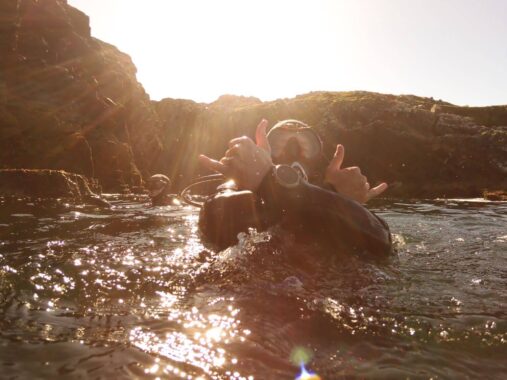
Support the Squad!
We are part of the Amazon Services LLC Associate Program. If you make a purchase on amazon after clicking a link on Diving Squad, we earn a small commission fee, at no extra cost to yourself.
We are also part of several other affiliate programs so if you click on a Diving Squad affiliate link that results in you booking a liveaboard, booking accommodation, purchasing insurance or buying a product somewhere else, once more we make a small commission, without it costing you a cent extra. Thanks!
Written by:
Alex
